Module 8: Harvest and Transport of Forest Products
Topic 8.2: Timber Yarding
Once the tree is on the ground, it needs to be topped, debranched, bucked into usable lengths, and yarded to where it can be loaded on trucks or floated in a river for transportation to a mill or port. Sub-optimal decisions during bucking can result in substantial wood waste and thus lost profit. Training fellers in bucking rules and providing incentives for avoiding waste can thus have substantial benefits. The alternative of skidding tree-length logs is often available, but may result in a great deal of avoidable damage to the residual stand as the long logs are skidded to the roadside.
Yarding systems range in levels of technological sophistication from manually carrying firewood or single boards cut in the forest to yarding 10 Mg logs with helicopters. Each method has different financial and environmental costs and hence each can be appropriate under different conditions. Furthermore, the yarding process can be broken into different stages using different techniques (e.g., ground-based skidding to a skyline corridor). Because yarding can be very expensive relative to the value of the raw material, and result in damage that greatly influences the silvicultural potential of harvested stands, yarding methods are worth considering in some detail.
In many poor parts of the tropics, manual cut and carry methods are the predominant way that wood gets to consumers or to the market. This method certainly predominates for firewood, much of which gets transported on women’s heads in loads of 20-30 kg. Because it is easier to collect, carry, and burn branches and other small dimension material than large logs, they are generally preferred as firewood. Often when due to scarcity or marketing opportunities men get involved in firewood gathering, wheeled carts and other modes of conveyance are used and larger pieces of wood are harvested.
Where yarding distances are short or the terrain is not suitable for mechanical yarding due to low trafficablility, teams of workers sometimes drag entire logs to road or riversides. To facilitate skidding on wet soil that is rich in organic matter, skid trails are reinforced with small logs laid parallel to one another forming a “corduroy” road.
Sawing logs in the forest into lumber, often referred to as “pit-sawing,” is extremely common in much of the tropics. (Pit-sawing is something of a misnomer given that pits are often not dug but instead the logs are propped up on frames or sawn on the ground.) Either rough-sawn planks are produced, or logs are cut into thick pieces called cants, and carried out of the forest. Pit-sawing can be with manual saws, chainsaws (with or without ripping guides), or various sorts of portable saw mills (Figure 8.2.1). Sometimes, large logs are quarter- sawn or otherwise cut into manageable sections that can be skidded manually to a road or riverside.
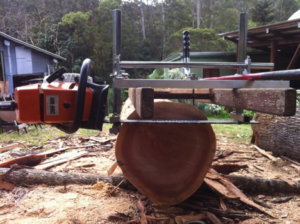
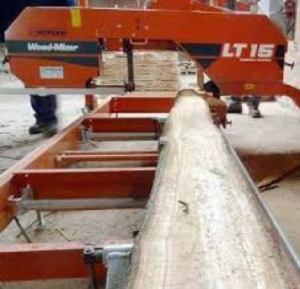
Figure 8.2.1. A chainsaw mill (left) and a transportable bandsaw mill (right).
In many places in the tropics, logs are skidded or cants are carried by draft animals. Oxen, buffalo, horses, donkeys, mules, and elephants are among the most common animals employed in logging operations. Although their individual pulling power may not be great, teams of draft animals can move logs up to several meters in volume, at least for short distances. Various implements, like sledges and sulkeys, can increase the yarding capacities of draft animals and machines alike. Where logging crews have experience working with draft animals or where the appropriate training is available, using them to yard timber can be cost effective and provide employment for more people than are generally engaged in mechanized yarding. Furthermore, draft animals are extremely versatile insofar as they can be used to pull plows, provide dung for fertililizing crops, and can be eaten in a crisis.
A great number of different types of wheeled and tracked vehicles are used for yarding timber, some of which were designed for this purpose and many of which were not (Figure 8.2.2). Farm tractors with power-takeoffs and hydraulic lifts are extremely versatile and can skid logs up to several cubic meters. Four-wheel drive trucks called into service for yarding timber are often outfitted so as to be self-loading. Alternatively, the logs are manually rolled up to the bed. Generally they yard logs to a graded road where the loads are transferred to larger, swifter, and more road-worthy trucks for hauling to mills or ports. Skidders with rubber tires designed for yarding timber generally articulate in the middle to increase maneuverability. Mounted with a small blade in the front and a cable winch towards the rear, rubber tired skidders are fast at least when compared with bulldozers (=crawler tractors). Bulldozers were designed for road construction purposes, a purpose that they suit admirably. The xx, xx, and xx hp bulldozers that are common in commercial logging operations throughout the world are generally mounted with a 2.5-3.0 m wide blade in the front with which they can quite readily move large volumes of soil (which they too often do in logging operations). Bulldozers of this size are slower than articulated skidders with rubber tires, but they can skid large logs up steep slopes on wet soil (which they generally blade off on the return trip to increase traction). Because of their size as well as their lack of articulation and easy blade angle-changing mechanism, it is hard to use a bulldozer to cut the angled cross drains needed to prevent erosion on steep slopes, but with proper advanced planning, it can be done. Unfortunately, few bulldozer operators are trained in reduced-impact logging techniques, they are often not provided with stock maps or pre-planned skid trails, and are not penalized for doing unnecessary and avoidable damage. If equipped with a cable winch with an integrated arch that elevates the cable 3 m or so above the ground, bulldozer operators working with motivated choker setters can winch logs 20-40 m through the forest to a skid trail. Winched logs damage the soil, but driving to every log is more damaging overall. On some new bulldozers that were designed specifically for skidding, the winch is mounted high up and towards the center of the carriage to improve its mechanical advantage and to distribute the load more evenly across the tracks while skidding.
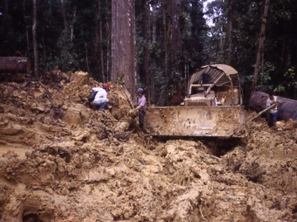
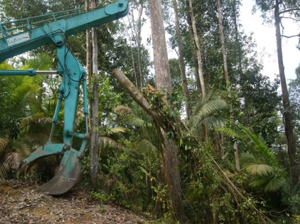
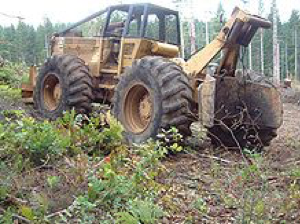
Figure 8.2.2. Machines commonly used to yard logs during selective harvests from tropical forests: Caterpillar D-7 Bulldozer (left), LogFisher, a modified excavator with 200-300 m of cable (center), and an articulated skidder with pneumatic tires (right).
Logging in swamp forests is often carried out using temporary rail systems laid out on log “sleepers.” Logs are generally loaded manually onto wheeled carts and then pulled by small engines or pushed by hand to a riverside or other log landing. Bulldozers and even rubber-tired skidders, in contrast, often bog down on wet organic soils of low trafficability, which slows down yarding operations and does a great deal of environmental damage. Capacity of these vehicles to traverse weak soils can be enhanced by using especially wide tracks or large flotation tires, respectively, but on some erosion-prone or otherwise easily damaged soils, ground-based yarding should be completely prohibited.
Cable yarding systems have been used for several decades in tropical forests and are getting more common. When evaluating their environmental impacts it is critical to distinguish between “high-lead” systems in which logs are dragged on the ground to a central point, from “sky-line” systems in which the logs are generally elevated above the ground as they move along previously cleared sky-line corridors. Unless carefully planned and supervised, high-lead yarding can be extremely destructive, with almost every log taking a different path through the forest and doing a great deal of damage along its way to the yarder. Skyline yarding, in contrast, results in little soil damage and comparatively little damage to the residual stand except along the corridors where trees within a 3-5 m wide path need to be cleared.
As logging progresses onto more and more adverse terrain, and the prices of some woods go up, helicopter yarding is likely to become more common in the tropics (Figure 8.2.3). By the late 1990s there were already helicopter yarding operations underway in several tropical countries (e.g., Malaysia, Papua New Guinea). Because no skid trails are needed, helicopter yarding results in virtually no soil damage in the forest (note that with aerial yarding techniques, a road network along which logs are hauled is still needed). Felling damage to the residual stand still occurs, and the downdraft from the powerful rotor can also damage standing trees during yarding. The costs of helicopter yarding are still often prohibitively high; to fly a Sikorsky x-2, a commonly used model for yarding logs, uses nearly 1000 liters of fuel per hour, not to mention all the maintenance costs and high purchase price. From an environmental perspective the fact that helicopter yarding may be less damaging than ground-based yarding is positive, but the fact that helicopters can yard timber from steep slopes and deep swamps that are otherwise inaccessible for logging has to be considered a negative feature. That helicopters leave no trails makes monitoring harvesting operations challenging as well.
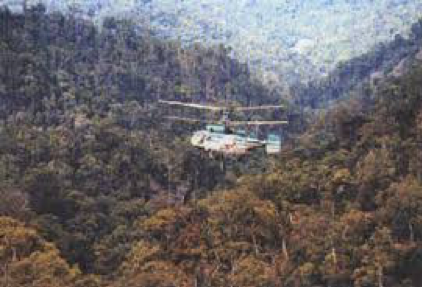
Figure 8.2.3. Helicopter yarding.
